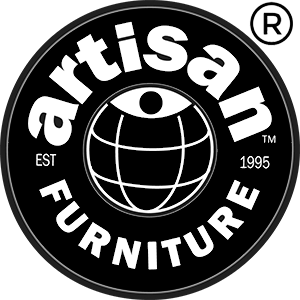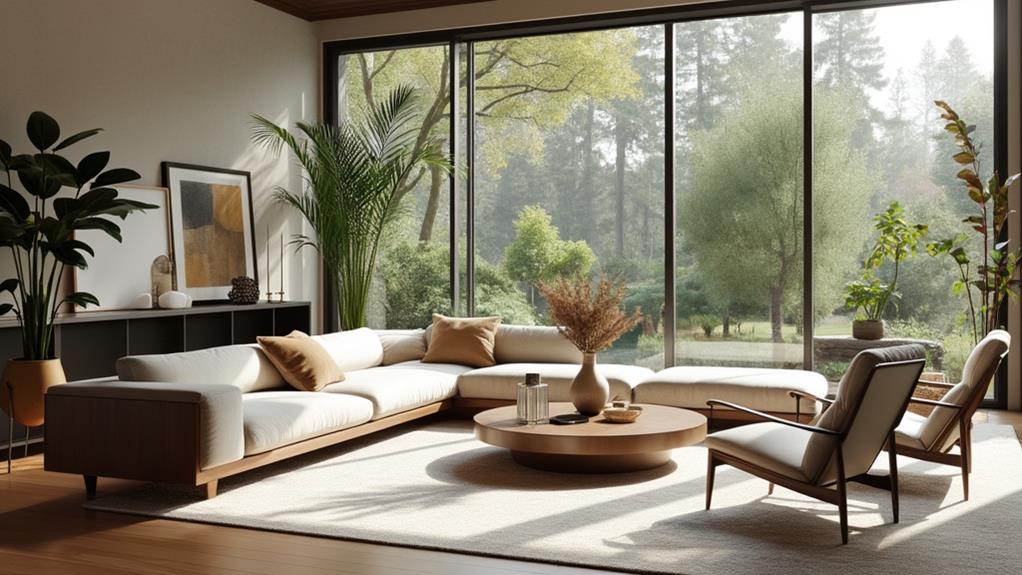Transforming your home with modern design trends focuses on creating spaces that are both functional and personalized. Integrate biophilic design to enhance natural connections, using elements like wood and plants. Employ sustainable practices, such as energy-efficient appliances and recycled materials, to minimize environmental impact. Multifunctional spaces with versatile furniture adapt to various needs, while open floor concepts improve fluidity and social connectivity. Minimalist maximalism combines simplicity with bold accents, offering a unique aesthetic. Dynamic color schemes and textural layering add vibrancy and depth, enhancing spatial ambiance. Incorporating smart home technology provides efficiency and convenience. Explore further to uncover more transformative ideas.
Table of Contents
ToggleBiophilic Design Integration
Amidst the evolving landscape of interior design, biophilic design integration has emerged as a pivotal trend, bridging the gap between built environments and the natural world.
This approach emphasizes the inclusion of natural elements such as wood and bamboo, which offer earthy textures and visual warmth. Large glass windows are utilized to maximize natural light, enhancing the ambiance while reducing the need for artificial lighting.
Integrating plants not only introduces vibrancy but also aids in air purification, promoting a healthier indoor environment. Water features like indoor fountains contribute to tranquility and improve air quality.
Sustainable Practices
In the domain of modern design, sustainable practices have become a cornerstone of innovation, championing environmental responsibility and energy efficiency. These practices prioritize natural light and ventilation, greatly reducing energy consumption in residential spaces.
Utilizing materials such as bamboo flooring and recycled glass tiles not only promotes sustainability but also adds aesthetic appeal. The selection of low VOC (Volatile Organic Compounds) products enhances indoor air quality, ensuring healthier environments.
Incorporating energy-efficient appliances further reduces the carbon footprint. Upcycling vintage pieces minimizes waste, while the use of natural fibers supports eco-friendly living.
Multifunctional Spaces
A growing emphasis on multifunctional spaces is transforming how interiors are designed, catering to the dynamic needs of modern living.
These spaces incorporate versatile furniture and layouts that accommodate various activities, enabling seamless shifts between work, leisure, and social interactions. Innovative furniture solutions, such as foldable desks and extendable tables, allow for efficient use of space, while clever zoning techniques create distinct areas without the need for physical barriers.
Multifunctional designs often integrate smart technology and low VOC paints, promoting both functionality and health. By prioritizing adaptability, these spaces can evolve with changing lifestyles, offering ergonomic comfort and increased usability.
This approach not only optimizes space but also enhances the overall living experience by tailoring environments to specific needs.
Minimalist Maximalism
Balancing the dynamic needs of multifunctional spaces, the concept of Minimalist Maximalism emerges as a design philosophy that harmoniously combines simplicity with boldness.
This approach embraces the notion that less is more, yet more is more, crafting spaces that are both functional and visually striking. By focusing on essential items, Minimalist Maximalism reduces clutter while incorporating statement pieces that add character and impact.
Clean lines and open spaces provide versatility for work or relaxation, creating an environment that is both serene and dynamic. The use of neutral color palettes further enhances this effect, offering a calming backdrop that allows bold design elements to shine.
Ultimately, Minimalist Maximalism encourages a mindful approach to living, ensuring each piece serves a specific purpose.
Dynamic Color Schemes
Dynamic color schemes transform spaces by leveraging the powerful influence of color on human perception and mood. By carefully selecting hues, homeowners can create environments that evoke specific emotions and enhance spatial functionality.
Vibrant colors, such as red and yellow, are known to energize and stimulate, making them ideal for social areas like kitchens and living rooms. In contrast, cooler tones, such as blue and green, promote calmness and relaxation, suitable for bedrooms and bathrooms.
Utilizing contrasting colors can also help define spaces and create visual interest, while accent colors can highlight architectural features or decor elements. Blending neutral tones with bold accents allows for a balanced aesthetic, offering both dynamic energy and harmonious tranquility within the home.
Vintage Elements
Embracing vintage elements in modern design infuses spaces with a sense of history and character, offering a unique depth that contemporary styles sometimes lack.
By integrating vintage furniture and retro styles, designers can achieve a harmonious blend of old and new, creating spaces that are both timeless and unique.
Antique accessories and restored vintage pieces celebrate craftsmanship and add warmth, while metallic accents provide subtle glamour without overwhelming the space.
Statement rugs and nostalgic design elements further personalize the environment, making it distinctive and inviting.
The careful selection of vintage items can evoke memories and emotions, transforming a modern space into one that reflects individual stories and cultural histories, enriching the overall aesthetic with layers of meaning and charm.
Textural Layering
The infusion of vintage elements into modern design not only adds historical charm but also sets the stage for exploring another dimension of interior aesthetics: textural layering.
This design approach enhances depth and visual intrigue by combining various materials and finishes. The juxtaposition of soft textiles, such as plush rugs or velvet cushions, with hard surfaces like polished concrete or sleek metals, creates a balanced and inviting environment.
Incorporating natural textures, such as wood grains or stone surfaces, further enriches the sensory experience, offering warmth and authenticity. Patterns and tactile elements, like woven fabrics and embossed wallpapers, add dynamism and complexity to spaces.
Through textural layering, designers can define distinct areas within open-plan environments, ensuring both aesthetic appeal and functional clarity.
Open Floor Concepts
Fluidity in modern living spaces is epitomized by open floor concepts, which prioritize seamless shifts and connectivity between rooms. This approach enhances spatial perception, creating expansive environments that foster interaction and flexibility.
By removing walls, open floor plans facilitate natural light flow, greatly improving the ambience and energy efficiency of interiors. They also promote versatile use of space, accommodating multifunctional furniture and varied layouts, which are ideal for contemporary lifestyles.
Defined zones within open plans can be achieved through strategic furniture placement and subtle textural contrasts, maintaining functionality without sacrificing openness.
This design trend not only maximizes smaller spaces but also enhances social connectivity, making it a preferred choice for modern homeowners seeking both aesthetic appeal and practical utility.
Smart Home Technology
Smart home technology is revolutionizing modern living by seamlessly integrating advanced systems into everyday environments. This innovative approach enhances convenience and efficiency, offering homeowners control over lighting, climate, and security through voice-activated systems and mobile devices.
Smart lighting adapts to user preferences, optimizing energy use while creating dynamic atmospheres. Climate control systems maintain ideal conditions, reducing energy consumption and costs. Security features, such as cameras and alarms, integrate smoothly, providing peace of mind.
Additionally, smart furniture incorporates hidden storage solutions, maximizing space and functionality. These technologies promote sustainable living by minimizing energy waste and enhancing user experiences.
As smart home technology continues to evolve, it paves the way for more intuitive and connected living spaces, enhancing modern home design.
Personalized Spaces
A vibrant tapestry of individual expression, personalized spaces in interior design allow homeowners to reflect their unique identities and lifestyles. This approach emphasizes customization, integrating elements that resonate personally with the occupants.
By incorporating personal art, unique decor, and curated collections, spaces become intimate reflections of their inhabitants. The use of color and texture can evoke personal memories, enhancing the emotional connection to the space.
Additionally, designing areas that cater to specific hobbies or interests guarantees functionality aligns with personal needs. Artistic expressions, such as murals or bespoke furniture, add distinctiveness and character.
This trend underscores the importance of creativity and individualism in modern design, allowing for a living environment that is both functional and deeply personal.


